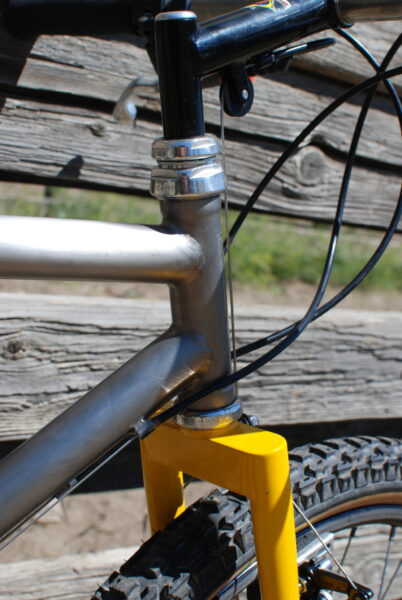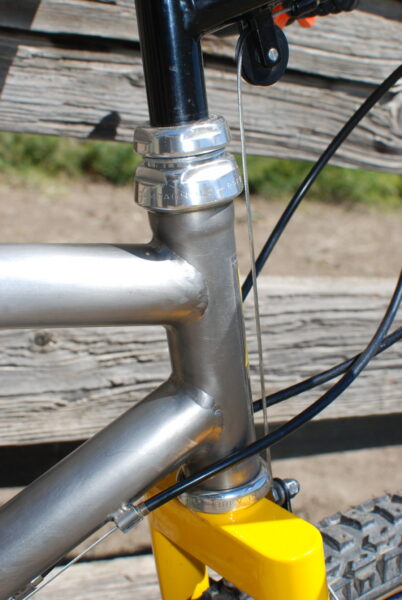Several years ago I had the fortunate pleasure to spend some time working on and ultimately riding this wonderful 1986 (built in 1985) Fat Chance (I use the name loosely here) Titanium. For the record Chris Chance will tell you this is not a Fat Chance, but rather Gary Helfrich’s first Titanium mountain bike. It just so happens that Gary was working for Fat City at the time he built the bike and so it shares its basic geometry with the Team Comp.

This bike represents a major turning point in the fabrication and material choice and fabrication techniques used in mountain bikes. Although it’s tough to prove this statement, those in the know feel that this is more than likely the first ever Titanium mountain bike. Merlin is largely credited with being the first company to manufacture Titanium mountain bikes. Gary Helfrich was one of the three founders of Merlin (along with Gwyn Jones and Mike Augspurger), so logically if he built this bike before starting Merlin it would be the first.

The frame is constructed from straight gauge tubing with a wall thickness of 0.041″for the main triangle and 0.032″ for the stays. Head tube and seat tube angles are both 72 degrees. Since Titanium has to be welded at very high temperatures and bathed in an inert gas to prevent it reacting with Oxygen Gary had to employ Plasma Arc Welding, a relatively complex and complicated process for the application. The welds on this bike are much more crude than even on a late 80s Merlin. It seems that Gary and the team at Merlin quickly mastered the process.


The best way to describe the ride characteristics of this bike would be to call it compliant. It’s very pleasant during the climb, feels planted and efficient. It tracks well and is easy to handle and change direction. Although I’m used to lighter bikes, at just over 24 lbs it must have been a breath of fresh air to the riders at the time. Chris Igleheart raced the bike for a part of the season and commented that he loved the effortless way it climbed, but was definitely afraid of it on the descents. I’m sure the noodly box crown fork (which he welded!!) didn’t help. This fork doesn’t have the reinforcing gussets joining the legs to the box crown as the alter forks had. Although I didn’t have a chance to take the bike out on any real trails, I definitely feel that it could get a little squirrely on some seriously technical terrain.

Rather unique and uncommon for a Fat rear entry drop outs. Whether due to user error or for other reason, the rear kept slipping under heavy load resulting in the tire rubbing against the seat stays.

Not a lot of tire clearance here!!

Very pleasant cockpit. I loved the early Magura motorcycle levers!!! Fun fact about early Magura levers. Maybe some of you with old bikes noticed you seems to have two left hand levers on your bike, i.e. the Magura logo is upside down on the right lever. Turns out that early one Magura only used long reach levers for clutches and short levers for brake applications. So bike builders had to buy two clutch levers and flip one upside down to get long reach levers for mountain bikes. Hence most early vintage mountain bikes have two left levers with one being upside down.

Detail of headtube which was stretched to accomodate the headset. Evidently tubeset selection was very slim back in the day, so both the bottom bracket shell and headtube had to be stretched to fit the application.

Notice the lack of inside gussets on the box crown fork. The yellow fork combination was later repeated in one of the merlin catalogs, a tribute perhaps??

This is truly special bike, it’s really one of if not the first / or prototype Merlin than prototype Titanium Fat Chance as it has very little in common with the actual Fat Chance Titanium bikes that would ultimately come out in 1993. As such it deserves a firm place in the history of mountain bike development as it is one of if not the first mountain bike made out of Titanium.
Completed Projects:
Current Projects:
Newsletter sign up:
Subscribe to our newsletter to receive info on our latest projects and new podcast releases
